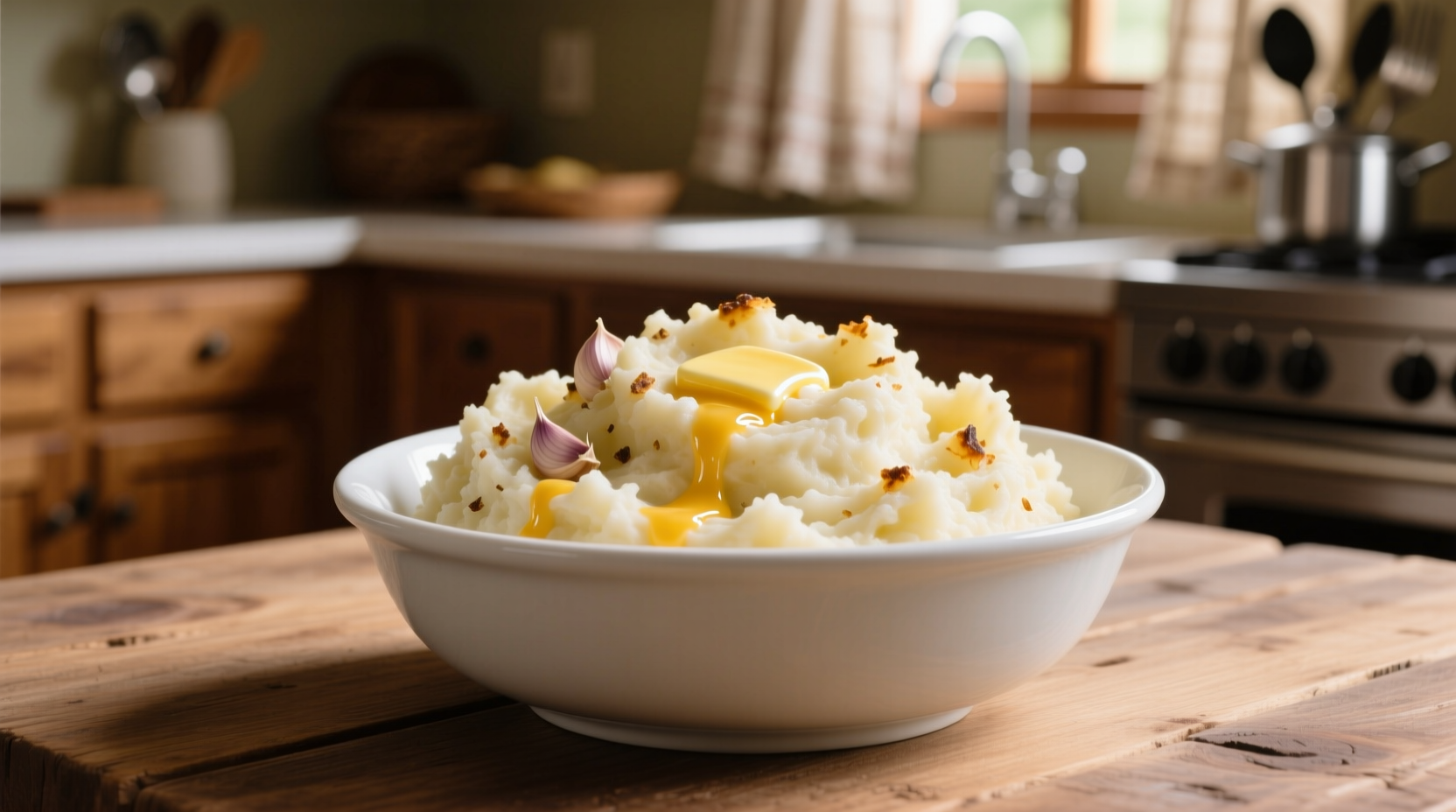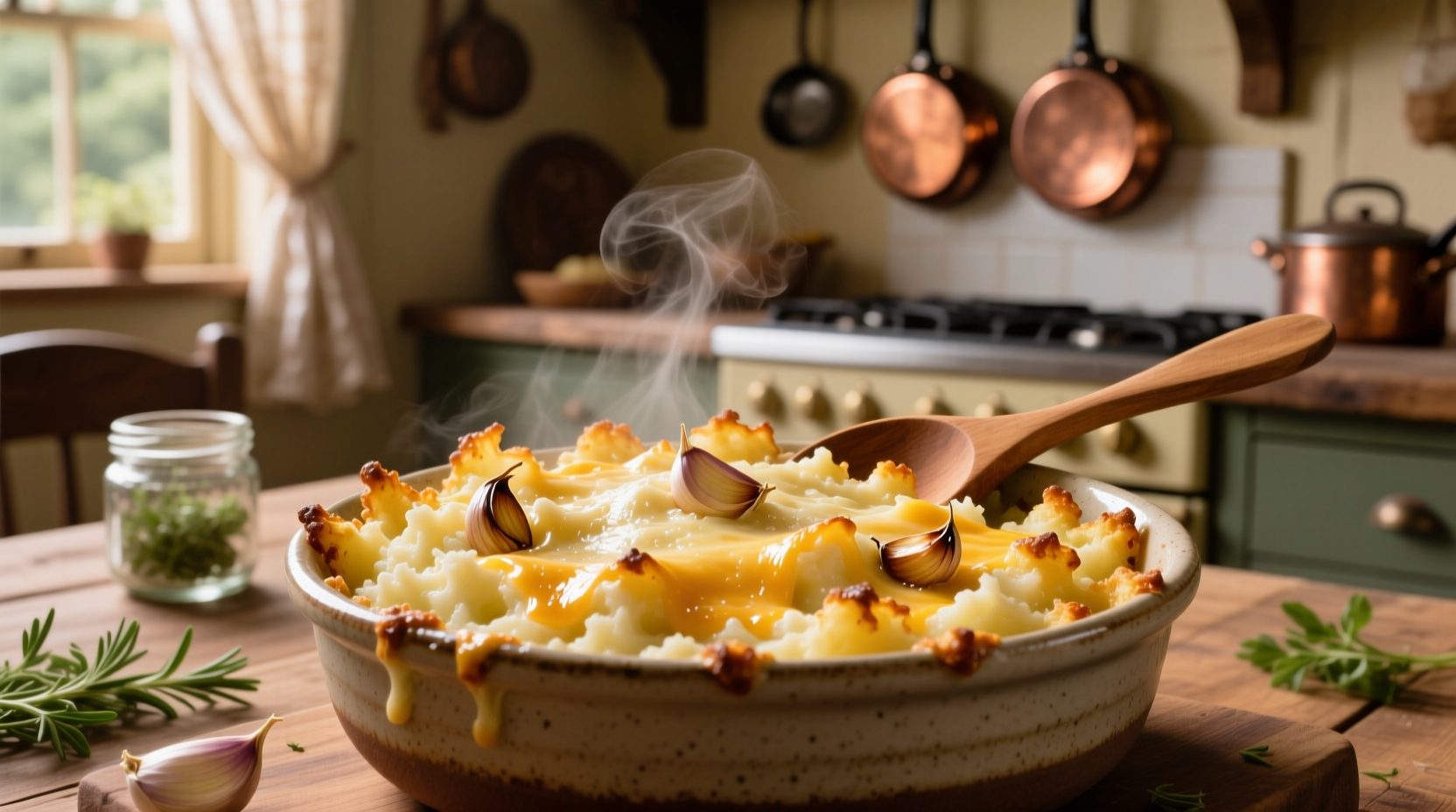Get restaurant-quality garlic and cheese mashed potatoes with this foolproof recipe featuring the perfect cheese-to-potato ratio, optimal garlic preparation techniques, and professional tips to avoid common mistakes like lumps or watery texture. This guide delivers creamy, flavorful mashed potatoes that impress every time.
There's nothing quite like the comforting embrace of perfectly creamy garlic and cheese mashed potatoes. Whether you're preparing a holiday feast or elevating a weeknight dinner, this versatile side dish transforms simple ingredients into something extraordinary. But achieving that ideal balance of rich cheese flavor without overwhelming the delicate potato base requires precise technique and ingredient selection.
| Ingredient | Quantity | Preparation Notes |
|---|---|---|
| Russet potatoes | 3 pounds | Peeled and cut into uniform 1.5-inch chunks |
| Unsalted butter | 8 tablespoons (1 stick) | Cut into small cubes, room temperature |
| Heavy cream | 1/2 cup | Warmed to room temperature |
| Garlic cloves | 6 large | Minced or pressed |
| Sharp cheddar cheese | 1 cup, freshly grated | Use block cheese, not pre-shredded |
| Salt | To taste | Kosher salt preferred |
| White pepper | 1/4 teaspoon | For smooth flavor without black specks |
Why This Recipe Works Every Time
The secret to exceptional garlic and cheese mashed potatoes lies in understanding how each ingredient contributes to the final texture and flavor profile. Potatoes contain starch that can turn gluey if mishandled, while cheese requires specific temperature conditions to melt smoothly without separating.
According to culinary research from the USDA National Institute of Food and Agriculture, the starch structure in potatoes responds best to gradual heating and careful mashing techniques. This prevents the release of excess starch that causes gumminess.
Essential Equipment Checklist
- Rice or food mill (superior to blenders or food processors)
- Medium saucepan with heavy bottom
- Sharp chef's knife and cutting board
- Garlic press (optional but recommended)
- Box grater for cheese
- Large mixing bowl
Step-by-Step Preparation Guide
1. Potato Preparation: The Foundation
Start by peeling russet potatoes and cutting them into uniform 1.5-inch chunks. Uniformity ensures even cooking—larger pieces won't be undercooked while smaller ones turn to mush. Place cut potatoes in cold water immediately to prevent oxidation and remove excess surface starch.
2. Garlic Infusion Technique
For optimal garlic flavor without harsh raw notes, combine minced garlic with cold heavy cream in a small saucepan. Heat gently over medium-low until bubbles form around the edges (about 160°F/71°C), then remove from heat. This technique, validated by University of Minnesota Extension food science research, maximizes allicin development while preventing bitterness.

3. Cooking Process: Temperature Control
Place potatoes in a large pot and cover with cold water by 1 inch. Add 1 tablespoon salt. Bring to a gentle boil, then reduce heat to maintain a simmer. Cook for 15-20 minutes until a knife slides easily into the center of a chunk. Never add salt to cold water with potatoes—this creates uneven seasoning.
4. Draining and Drying
Drain potatoes thoroughly in a colander, then return them to the warm pot over low heat for 1-2 minutes, shaking gently. This critical step evaporates excess moisture that would otherwise make your potatoes watery. As noted in culinary textbooks from the Culinary Institute of America, "dry potatoes equal creamy mash."
5. Mashing and Incorporating Ingredients
Pass potatoes through a food mill into a large bowl. Add warm butter first, mixing gently with a wooden spoon. Gradually incorporate the garlic-infused cream, followed by grated cheese. Season with salt and white pepper to taste. Avoid overmixing—this develops starch and creates gluey texture.
| Cheese Type | Flavor Profile | Melting Quality | Best For |
|---|---|---|---|
| Sharp Cheddar | Tangy, robust | Good | Classic flavor, holiday meals |
| Gruyère | Nutty, complex | Excellent | Creamier texture, sophisticated dishes |
| Fontina | Mild, buttery | Superior | Delicate flavor, children's meals |
| Blue Cheese | Strong, pungent | Fair | Special occasion, bold flavor lovers |
Avoiding Common Pitfalls
Even experienced cooks encounter issues with mashed potatoes. Understanding these context boundaries prevents disappointment:
- Don't use pre-shredded cheese—the anti-caking agents prevent smooth melting
- Avoid cold dairy—sudden temperature changes cause separation
- Never use a blender—overworks starch creating glue-like texture
- Don't add all liquid at once—potatoes absorb differently based on variety and growing conditions
Historical Context: Mashed Potatoes Evolution
Mashed potatoes have evolved significantly since their introduction to Europe:
- 1570s: Potatoes introduced to Europe from South America
- 1747: First recorded mashed potato recipe in Hannah Glasse's "The Art of Cookery Made Plain and Easy"
- 1800s: Adoption of the potato ricer improved texture consistency
- 1950s: Instant mashed potatoes revolutionized home cooking
- 2000s: Gourmet variations with specialty cheeses and roasted garlic became popular
Delicious Variations to Try
Once you've mastered the basic technique, experiment with these chef-approved variations:
- Truffle Infusion: Add 1 teaspoon truffle oil with the cream for an elegant touch
- Four-Cheese Blend: Combine equal parts cheddar, parmesan, fontina, and cream cheese
- Roasted Garlic Version: Substitute raw garlic with 1 whole head of roasted garlic
- Loaded Baked Potato Style: Mix in 4 strips cooked bacon and 1/4 cup sour cream before serving
Serving and Storage Tips
Serve garlic and cheese mashed potatoes immediately for best texture. If preparing ahead, transfer to a heatproof bowl, cover with plastic wrap pressed directly onto the surface, and hold in a warm oven (140°F/60°C) for up to 2 hours. For longer storage, refrigerate for up to 3 days or freeze for 2 months.
When reheating, add a splash of cream or milk and warm gradually over low heat, stirring gently. Microwave reheating often creates uneven texture—stir every 30 seconds if using this method.
Perfect Pairings for Your Meal
Garlic and cheese mashed potatoes complement many main courses:
- Roast beef or prime rib (classic pairing)
- Pan-seared chicken cutlets with mushroom gravy
- Herb-crusted pork tenderloin
- Vegetarian mushroom Wellington
- Grilled salmon with lemon-dill sauce











 浙公网安备
33010002000092号
浙公网安备
33010002000092号 浙B2-20120091-4
浙B2-20120091-4